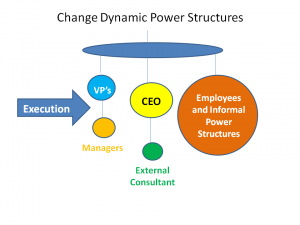Changing systems and redesign can be perplexing during growth. One reason is that leaders protect their operations and frequently fail to communicate growth impacts until problems have advanced. When they do, it often is leveled at another department or by pointing the finger elsewhere. For example, sales and manufacturing are two departments that frequently find themselves at odds during growth or innovation challenges. Finance and human resources often spar as well.Frequently the last resort is changing systems.
When faced with challenges like these, developing collaboration strategies is often necessary when considering changing systems. Understanding when to start the process and how to go about it is critical. According to a 2016 Robert Half Management Resources survey, 46% of redesigns fail during the execution phase.
In over 25 years of experience co creating redesign strategies with executives and their teams, we have not had a failure. Below are our top three strategies for setting up organizations for a successful execution phase during change.
Strategies for sidestepping struggles when changing systems
System’s thinking
Right out of the gate, a massive inhibitor to effective organization design work is the failure to adopt system’s thinking. Instead, C-suite executives tend to compartmentalize their company’s divisions and think in work segments such as business units, marketing, supply chains, etc.
As a result, they leave human resources to worry about people and culture. This only creates more fragmentation.
Instead, understanding how redesign affects all departments and company-wide work flow is required. A modification in one part of the system often pops up as an issue in another function or department. Therefore, it is critical to deploy a cross-functional problem solving approach to the solution.
Community of influence
Another error is thinking is that organization redesign is a simple task. All it takes is adjusting the organization chart such as changing reporting relationships. Or perhaps the fault lies in confusing redesign with levels and width of control.
The reality is that communities of interest have evolved. These communities interact in synergistic ways – or not. They also exert informal influence in ways that can stop redesign and change execution dead in its tracks.
For example, the visual or a mobile below shows realistically how much power the CEO or an outside consultant or managers and vice presidents have compared to community of interest. These communities of interest have both emotional impact and measurable behavior.

Changing systems change dynamics
The “community” operates through informal power systems that exemplify how things are really done in companies. The community determines if employees are engaged or not based on accumulated leadership and co-worker behavior. The emotional impact influences whether employees stick around or go work somewhere else. The community behavior and emotional impact also determine whether people will resist change or enthusiastically support it.
The community of interest also includes executives, managers, supervisors, employees, supply channels, and in some instances key customers. In addition to this, when there is an “us versus them” dynamic operating in the organization, the community of interest becomes split with trust issues and unforgiving grudges.
This said laws of gravity also apply.
When leaders launch the execution phase of changing systems without getting all their ducks in a row, the mobile moves. It starts swinging based on execution pressure. Once pressure stops, the mobile eventually stops swinging. For example, the consultant leaves. Everything returns to the status quo after an amount of upheaval.
After all, execution gets things moving before it settles back into the status quo. This is why so many redesign executions fail. This is also why the execution team needs group facilitation tools and resources that include pre change behavior diagnostics to execute change and then stabilize it.
Getting ducks in a row when changing systems
Organization redesign is one of largest business transformations a CEO and the leadership team could implement. It is a holistic process that must influence the community of interest by getting it on board to enthusiastically champion the transformation. Likewise, the transformation must be planned and managed step-by-step with the understanding that a change in one area of the organization will inevitably influence another part of the company or other company employees.
There are a minimum of 10 steps required when considering changing a system and organizational redesign:
- Measuring the behavior quality of the community along with department group dynamics.
- Forming the change team, including employee informal leaders from a cross section of the organization.
- Initial communication planning taking into account the behavior dynamics of the community and department group dynamics.
- Assigning communication roles, details and time lines
- Building the safety nets and adding these to the communication plan
- Marketing the transformation internally though small group meetings that involve informal employee leaders, the CEO, marketing department personnel and cross-functional stakeholder groups at various states of the communication strategy.
- Gather realistic feedback from the stakeholder groups and employees.
- Build the implementation plan and include realistic employee feedback. Communicate this through the communication channels.
- Implement and execute. Include feedback loops and recognition systems.
- Stabilizing the change that follows.
Keep in mind that the community of influence must be communicated to consistently through each phase with rewards and recognition given when small success steps are achieved.
Redesigning a system is often vital to thriving in a continually evolving marketplace. But it’s helpful only when it’s done well and designed successfully in ways that benefit everyone.
Here are some additional resources that deepen understanding:
- Sample Workforce Behavioral Profile. Take the guesswork out of influencing the community of interest.
- White Paper: How to Build a Successful and Principled Work Culture
Copyright TIGERS Success Series, Inc. by Dianne Crampton
 About TIGERS® Success Series, Inc.
About TIGERS® Success Series, Inc.
TIGERS® Success Series is a Bend, Oregon Leadership and Team Improvement Consultant that helps committed leaders build more cooperation among employees and collaboration between departments for improved success.
We do this by deploying the TIGERS® team facilitation process that improves workforce behaviors that are anchored by trust, interdependence, genuineness, empathy, risk resolution and success. Providing diagnostics and customized team interventions, you can improve both work culture and transform your adequate teams into exceptional ones.
We also license and train HRD Executives, Project Managers, Managers, and Trainers in the use of our award winning resources. Invite us to present at your next business retreat or association gathering.
For more information, call 1+ 541-385-7465.
